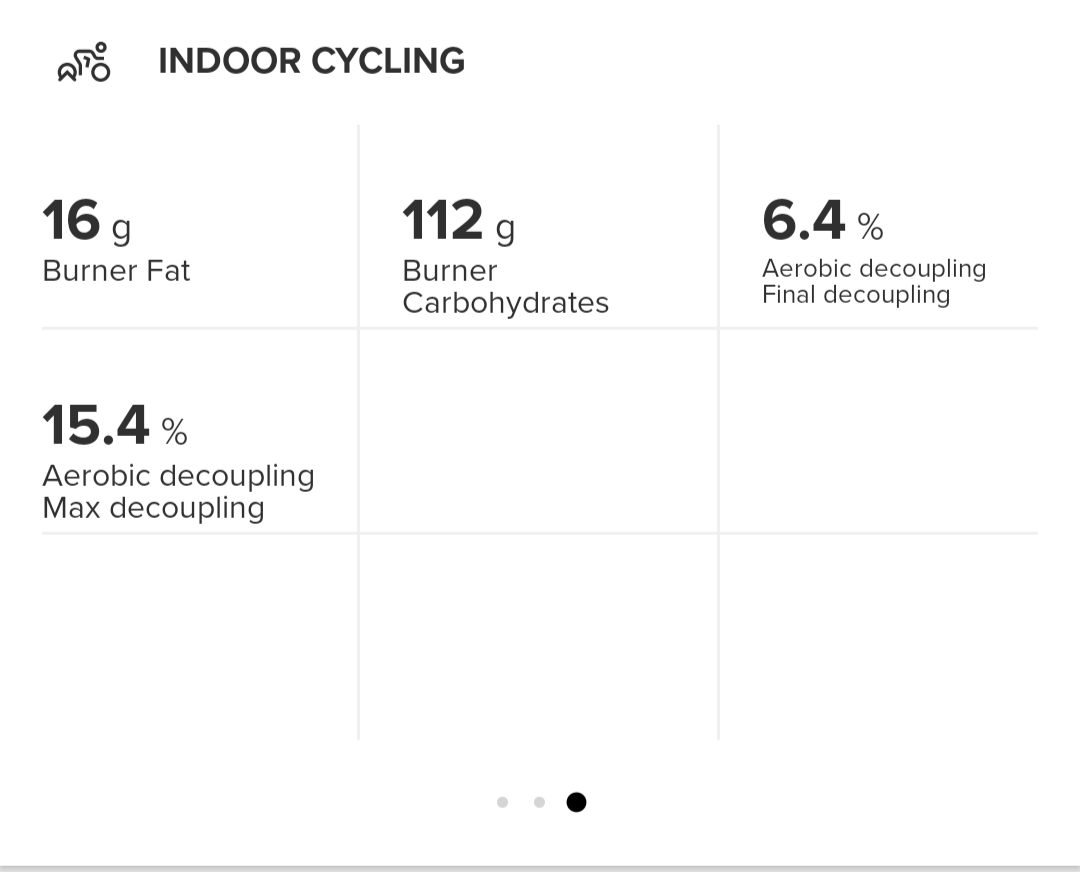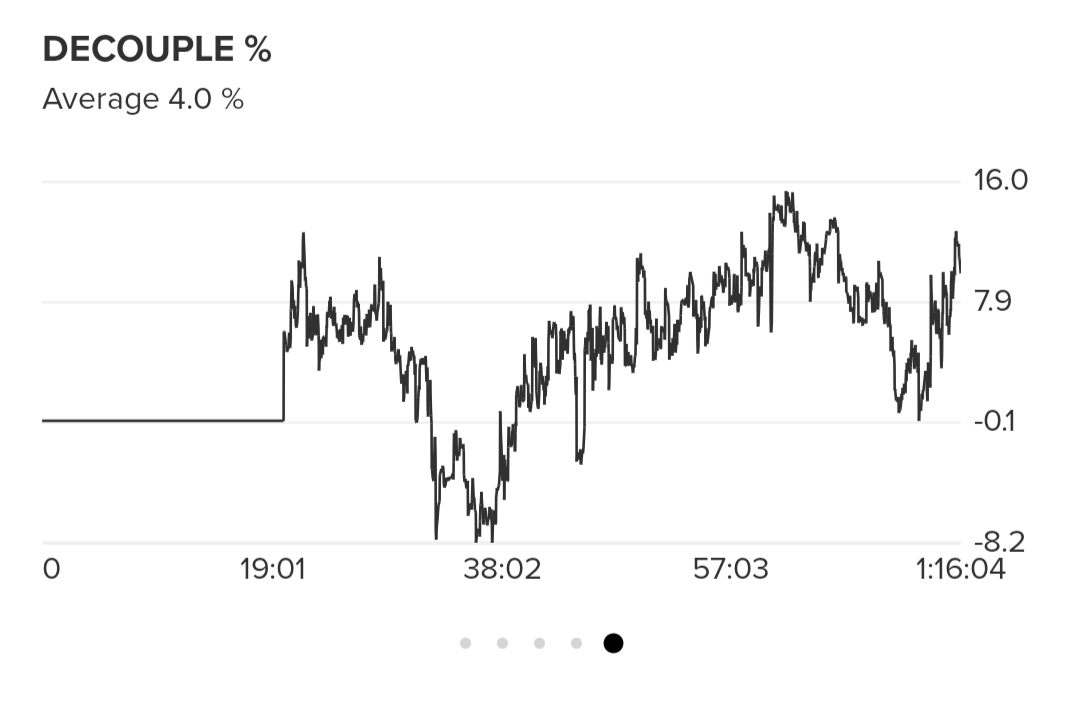aerobic decoupling
-
@A-Former-User said in aerobic decoupling:
I miss the ability to see other metrics, e.g., pace/power, at the same time and once the activity is over set Z1 and Z2 accordingly if decoupling is in between 3.5-5%
I’m voting for this too!
-
On the Suunto Race, the “aerobic decoupling” app seems to calculate an estimate of the aerobic coupling instead of decoupling as can be seen from the screenshot below. This is the case both on watch itself and also in the Suunto App. It is not a big issue as the decoupling value is just “100% - coupling”.
However, as can be seen in the screenshot below then the decoupling (which is actually coupling) figure has a different and wrong average than what is reported in the top of the screenshot. The whole decoupling figure looks strange with the deep periodic dips.
Note, this is a cycling activity.

-
-
@Mads-Hintz-Madsen Thank you for the feedback. Decoupling value is obviously wrong as you said, I’m not sure if it’s showing coupling value or if the value is otherwise incorrect. We will investigate it.
The value in summary is actually not average, it is the final decoupling value. It should be renamed to e.g. “Final decouple value” to avoid confusion. I guess the thinking behind the summary value is that final value is usually the maximum, of course it depends on your workout. We could add also maximum value to summary.
-
@Raimo-Järvi Thanks for the quick reply and for following up on this issue

-
When power output is zero(coasting), does it exclude coupling data with HR?
-
@lexterm77 When speed AND power are zero, decoupling value is not calculated. When only power is zero, it is calculated. So the answer to your question is no. But maybe it should be excluded, it seems logical to me to exclude coasting.
-
We published an update to Aerobic decoupling app. It fixes a bug in calculating decoupling value for cycling. It also renames summary ‘Decouple value’ to ‘Final decoupling’ for clarity and adds ‘Max decoupling’ to summary.
Zero power / coasting is not excluded from decoupling calculation yet, we will fix that and publish another update.
-
@Raimo-Järvi great! Thx for the quick response

I will try it out as soon as I can.
EDIT: Btw, I don’t understand the reasoning for wanting to exclude coasting/zero power from the calculations.
Why should zero power be treated differently than e.g. soft pedalling at 1 Watt? I believe that aerobic decoupling metric is using normalized power (NP) which is already dealing gracefully with periods of low power output such as 0 or e.g. 1 Watt.
-
@Raimo-Järvi I did an inside Zwift cycling activity using the updated aerobic decoupling app.
I have included screenshots below of the decoupling data shown in Suunto App. It seems like the final decoupling value (6.4%) in the first screenshot now makes sense.
However, I don’t think that the max decoupling value (15.4%) provides any useful information. This is the maximum instantaneous (i.e. calculated using instantaneous power and heart rate) decoupling value which could even be 100% by simply stopping pedalling, i.e., power goes to zero (I forgot to actually try). So I believe that the max. value can be whatever value from activity to activity and is not really worth tracking. This may confuse some people.
The second screenshot shows the instantaneous decoupling (which can be both positive and negative as can also be seen). And here I believe that the average decoupling value (4.0%) is just the average of the instantaneous decoupling. This average will in general be different from the final decoupling value. I assume that the average and final decoupling value will be close if the ride is done at more or less constant power or heart rate.
Final remark (or advice to any users of this metric) is that the aerobic decoupling metric only really makes (scientific) sense if the activity is performed at constant power or heart rate as the metric measures changes in the power-to-heartrate ratio. This is not a linear relationship so the metric will lose its meaning if there are big fluctuations in e.g. power.
I’m not sure that I will be using this S+ app much but after the latest update, the calculations seem to be correct. Thanks for that!!!
Sorry for rambling on! I’ll go to sleep now



-
EDIT: Btw, I don’t understand the reasoning for wanting to exclude coasting/zero power from the calculations.
Because your heart continues to beat even when you stop power output. So HR data is no longer “coupled” or relevant to a calculation. If you include it by doing 0 watt power output and your heart still beating, you are invalidating coupling calculation.
-
@lexterm77 hmm, I’m still not sure I get why 0W needs a special handling compared to say 1W.
The decoupling equation uses normalized power (NP) calculated from the entire activity. NP effectively de-weights periods with low power output such as 0 W. That is why I think that 0 W values (or other relativity low power values) do not need to be excluded from the metric as NP gracefully handles periods with lower power. That is why NP was invented in the first place.
But maybe the thinking/assumption is that you pedal at either approx. constant power or that you are coasting at 0W and that is why it is being proposed to do special handling of exactly 0W.
-
Normalized power is for calculating your overall effort. Not useful in testing of aerobic threshold. If you go to a lab, they will tell you never, i mean not even for a second to stop pedaling. This is why aerobic threshold tests are not really valid if you do 30min effort then pause 2 minutes then resume. Your anaerobic or oxygen debt or epoc will be refilled and whole teat goes into trash bin. Just go to any lab and ask. They will tell you you need nearly constant effort for 60min to get a valid test.
-
@Mads-Hintz-Madsen Thank you for testing!
Aerobic decoupling app doesn’t use normalized power, it currently uses 5 minute rolling average of power and HR values for calculating decoupling value (for cycling). This is also the value shown in Suunto app graph.
-
@Raimo-Järvi Thanks for clarifying!
How is the final decoupling value (listed in the summary) calculated? Is that calculation using the average power and average heartrate over the entire activity (excluding warmup/baseline periods)?
In the Suunto App graph, there is an average decoupling value which is different from the final decoupling value. I assume that this average then is the average of the rolling 5-minute decoupling values.
-
@Mads-Hintz-Madsen “Final decoupling” is value from last 5 minutes. I guess the name is not very descriptive, app description in SuuntoPlus store should also be updated.
Suunto app graph calculates average of all values during the workout, in this case the values are decoupling values from rolling 5 min average. And since the graph includes 10 min warmup and 10 min baseline calculation, those zero values are included in the average. I guess first 20 minutes should not be included in data, or in calculating the average

-
@Raimo-Järvi said in aerobic decoupling:
And since the graph includes 10 min warmup and 10 min baseline calculation, those zero values are included in the average. I guess first 20 minutes should not be included in data, or in calculating the average

I agree.
-
I have been using S+ aerobic decoupling for my running and walking activities and everything works as expected…
however, it seems that for the nordic walking and treadmill activities it does not work, i.e. if you activate it, start the activity, as soon as you select the aerobic decoupling page the watch displays a warning:power not available, pair power sensor for measurements.
I know that power is used when it is available, but otherwise pace is used, so if I am not missing something it should work.
or not?
-
@robis Power or pace is used according to activity type. Power is used for example for cycling, but it should not be used for nordic walking. We will fix it, thank you for reporting it.
-
@Brad_Olwin Can you please explain this a little more?